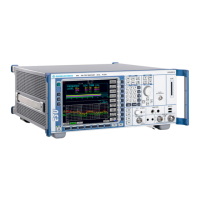R&S ESU Remote Control – Basics
Status Reporting System
5.18 Operating Manual 1302.6163.12 - 03
An example as to command synchronization can be found in chapter “Remote Con-
trol – Programming Examples”.
For a couple of commands the synchronization to the end of command execution is
mandatory in order to obtain the desired result. The affected commands require
either more than one measurement in order to accomplish the desired instrument
setting (e.g. auto range functions), or they require a longer period of time for execu-
tion. If a new command is received during execution of the corresponding function
this may either lead to either to an aborted measurement or to invalid measurement
data.
The following list includes the commands, for which a synchronization via *OPC,
*OPC? or *WAI is mandatory:
5.7 Status Reporting System
The status reporting system (cf. Fig. 5.43) stores all information on the present oper-
ating state of the instrument, e.g. that the instrument presently carries out a calibra-
tion and on errors which have occurred. This information is stored in the status
registers and in the error queue. The status registers and the error queue can be
queried via GPIB.
The information is of a hierarchical structure. The register status byte (STB) defined
in IEEE 488.2 and its associated mask register service request enable (SRE) form
the uppermost level. The STB receives its information from the standard event sta-
tus register (ESR) which is also defined in IEEE 488.2 with the associated mask reg-
ister standard event status enable (ESE) and registers STATus:OPERation and
STATus:QUEStionable which are defined by SCPI and contain detailed information
on the instrument.
The IST flag ("Individual STatus") and the parallel poll enable register (PPE) allo-
cated to it are also part of the status reporting system. The IST flag, like the SRQ,
combines the entire instrument status in a single bit. The PPE fulfills the same func-
tion for the IST flag as the SRE for the service request.
The output buffer contains the messages the instrument returns to the controller. It is
not part of the status reporting system but determines the value of the MAV bit in the
STB and thus is represented in Fig. 5.43.
Command Action after the hardware has settled Programming the controller
*OPC Setting the operation-complete bit in the ESR - Setting bit 0 in the ESE
- Setting bit 5 in the SRE
- Waiting for service request (SRQ)
*OPC? Writing a "1" into the output buffer Addressing the instrument as a talker
*WAI Continuing the GPIB handshake Sending the next command
Command Purpose
INIT start measurement
INIT:CONM continue measurement
CALC:MARK:FUNC:ZOOM zoom frequency range around marker 1
CALC:STAT:SCAL:AUTO ONCE optimize level settings for signal statistic measurement functions
[SENS:]POW:ACH:PRES:RLEV optimize level settings for adjacent channel power measurements

